Captain John Joseph Holland was a shipbuilder in the Pacific Northwest in the late 19th century. Among the vessels he built at his yards were the sternwheel steamboat Fairhaven in 1889, [1] and, in 1890, the famous sternwheeler Bailey Gatzert .
Captain John Joseph Holland was a shipbuilder in the Pacific Northwest in the late 19th century. Among the vessels he built at his yards were the sternwheel steamboat Fairhaven in 1889, [1] and, in 1890, the famous sternwheeler Bailey Gatzert .

Captain Holland was born in Saint John, New Brunswick, Canada on April 15, 1843. He learned his trade as a shipbuilder at Saint John. From age 23 to 25 there are records of him sailing as an able-bodied seaman on multiple trips between Saint John and Liverpool and London.
He emigrated to the United States and moved to The Dalles, Oregon on the Columbia River. He found a job with the Oregon Railway and Navigation Company, and married Anna J. Foster there. [2] Holland later moved to Portland, Oregon with the same company, where he became the Chief Builder. [3] While working in Portland, he built the steamships Wide West, R.R. Thompson, Idaho,Daisy Ainsworth [3] , Rainier [4] , and Emma Hayward.. [5] Captain Holland's half-brother, Phillip, was with him in Oregon and also involved in shipping. Unfortunately, he was mortally injured in a collision between the steam launch Mikado and an Oregon and California Railroad ferry on October 26, 1886. [6] He died 65 days later. [7]
After years on the Columbia River, Holland had developed a specialty in shallow-draft and coastal vessels, especially river craft. He moved to Tacoma, Washington in 1887 [8] where he built a number of such vessels including the steamers State of Washington, Skagit Chief, and Fairhaven. In 1889 he moved again, this time to Ballard, Washington, where he started a new shipyard on Salmon Bay. In December 1889 he employed a gang of men to remove stumps and level the site on Shilshole Avenue before ship building could begin. [9] In 1890 his shipyard employed 23 workers. [10] In this new yard he built Monte Cristo, Bailey Gatzert, Cascade [11] and Frances Henry. [5] His Ballard ship yard also repaired vessels including Henry Bailey , [12] Josephine, [13] Fanny Lake, [14] Wasco, [15] Mabel, [16] Detroit, [17] and State of Washington . [18]

In 1892 he was commissioned to build a steamer for Yukon River service. He produced the parts of the ship, Portus B. Weare, in Ballard and then traveled to the St. Michael, Alaska trading post of the North American Transportation and Trading Company [19] [20] to assemble the ship. [21] Presumably, the river craft was deemed unseaworthy to make the ocean crossing from Ballard to the Yukon.
Holland, sailed north on July 6, 1892 on Alice Blanchard, with a crew of builders from his shipyard, parts for the new steamer, and Portus B. Weare, an executive of the company for whom the ship was named. The ship was launched September 17, 1892. [22] Living in a tent on St. Michael, Holland was taken ill and returned to Ballard in October in poor health. In December he contracted typhoid fever. While recovering, he died of pneumonia on January 28, 1893. He left behind his wife and six children, ages 18 to 1 1/2. [5]

The Bailey Gatzert was a sternwheel steamboat that ran on the Columbia River and Puget Sound from the 1890s to the 1920s. This vessel was considered one of the finest of its time. It was named after Bailey Gatzert, an early businessman and mayor of Seattle, who was one of the closest friends and business associates of John Leary – the person who financed the ship.

Olympian was a large side-wheel inland steamship that operated in the Pacific Northwest and Alaska. Olympian operated from early 1884 to late 1891 on the Columbia River, Puget Sound, and the Inside Passage of British Columbia and Alaska.

Lurline was a steamboat that served from 1878 to 1930 on the Columbia and Willamette rivers. Lurline was a classic example of the Columbia river type of steamboat.

Charles R. Spencer was a steamboat built in 1901 to run on the Willamette and Columbia rivers from Portland, to The Dalles, Oregon. This vessel was described as an "elegant passenger boat". After 1911 this vessel was rebuilt and renamed Monarch.

Sarah Dixon was a wooden sternwheel-driven steamboat operated by the Shaver Transportation Company on the Columbia and lower Willamette rivers from 1892 to 1926. Originally Sarah Dixon was built as a mixed use passenger and freight vessel, and was considered a prestige vessel for the time.

Since the early 1980s, several non-steam-powered sternwheel riverboats have been built and operated on major waterways in the U.S. state of Oregon, primarily the Willamette and Columbia Rivers, as river cruise ships used for tourism. Although configured as sternwheelers, they are not paddle steamers, but rather are motor vessels that are only replicas of paddle steamers. They are powered instead by diesel engines. The Lurdine was, when launched in 1983, "the first passenger-carrying sternwheeler in decades to [operate] on the Columbia River". In the case of the 1983-built M.V. Columbia Gorge, the construction and operation of a tourist sternwheeler was led by local government officials who viewed the idea as potentially being a major tourist attraction, giving an economic boost to their area, Cascade Locks, Oregon.

Emma Hayward commonly called the Hayward, was a steamboat that served in the Pacific Northwest. This vessel was once one of the finest and fastest steamboats on the Columbia River and Puget Sound. As newer vessels came into service, Emma Hayward was relegated to secondary roles, and, by 1891, was converted into a Columbia river tow boat.

Elwood was a sternwheel steamboat which was built to operate on the Willamette River, in Oregon, but which later operated on the Lewis River in Washington, the Stikine River in Canada, and on Puget Sound. The name of this vessel is sometimes seen spelled "Ellwood". Elwood is probably best known for an incident in 1893, when it was approaching the Madison Street Bridge over the Willamette River in Portland, Oregon. The bridge swung open to allow the steamer to pass. However, a streetcar coming in from the east end of the bridge failed to notice the bridge was open, and ran off into the river in the Madison Street Bridge disaster.
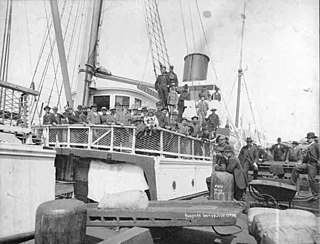
SS Roanoke (1882–1916) was a passenger and cargo ship built by John Roach & Sons in Chester, Pennsylvania. The Roanoke was built for the Old Dominion Steamship Company's service from New York to Norfolk Virginia. In 1898 the ship was sold to the North American Transportation and Trading Company to take miners, supplies and gold between Seattle and ports in Alaska. Later the Roanoke was sold to the Oregon-based North Pacific Steamship Company. In 1907, the Roanoke helped to rescue the survivors of her former running mate Columbia. On May 9, 1916, the Roanoke sank in heavy seas off the California coast near San Luis Obispo with the loss of 47 lives. There were only three survivors.

Harvest Queen was the name of two stern-wheel steamboat built and operated in Oregon. Both vessels were well known in their day and had reputations for speed, power, and efficiency.The first Harvest Queen, widely considered one of the finest steamers of its day, was constructed at Celilo, Oregon, which was then separated from the other portions of the navigable Columbia River by two stretches of difficult to pass rapids.
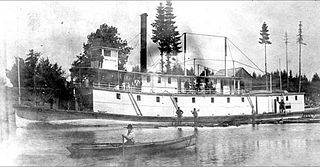
Three Sisters was a sternwheel-driven steamboat that operated on the Willamette River from 1886 to 1896. The steamer was built as an extreme shallow-draft vessel, to permit it to reach points on the upper Willamette river such as Corvallis, Harrisburg and Eugene, Oregon during summer months when water levels in the river were generally low. The vessel was also known for having been washed up on a county road in Oregon during a flood in 1890.

No Wonder was a stern-wheel driven steamboat that operated on the Willamette, Columbia and Cowlitz rivers from 1889 to 1930. No Wonder was originally built in 1877 as Wonder, which was dismantled in 1888, with components being shifted over to a new hull, which when launched in late 1889 was called No Wonder.

Telephone was a sternwheel-driven steamboat built in 1884 by Captain Uriah Bonsor "U.B." Scott for service on the Columbia River. Reputedly the fastest steamboat in the world in its time, Telephone served on the Columbia River and San Francisco Bay. Telephone was rebuilt at least twice. The first time was after a fire in 1887 which nearly destroyed the vessel. The reconstructed and much larger second vessel was sometimes referred to as Telephone No. 2. The third vessel, Telephone No. 3, built in 1903 and using components from the second steamer was larger but little used during its time on the Columbia river.

Governor Newell was a sternwheel-driven steamboat that operated from 1883 to 1902 in the Pacific Northwest.
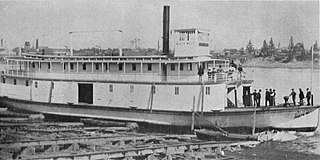
Northwest was a steamboat that operated on the Columbia, Cowlitz and lower Willamette rivers from 1889 to 1907. In 1907 Northwest was transferred to Alaska, where it sank on the Skeena River

Joseph Kellogg was a stern-wheel driven steamboat that operated on the Willamette, Columbia, and Cowlitz rivers for the Kellogg Transportation Company. It was named after the company's founder, Joseph Kellogg (1812-1903). The sternwheeler Joseph Kellogg was built in 1881 at Portland, Oregon.
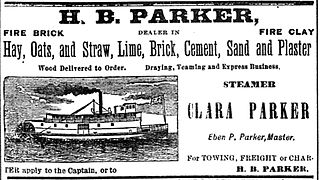
Clara Parker was a sternwheel-driven steamboat which was operated on the lower Columbia and lower Willamette rivers in the 1880s. The steamer ran for about ten years out of Astoria, Oregon in towing and jobbing work. In 1890 Clara Parker was rebuilt and renamed Astorian.

Portus B. Weare was a wooden sternwheel steamship built in 1892 for service on the Yukon River. She played a notable role in the Klondike gold rush, being the second ship to bring news of the Klondike gold strike and an estimated $1 million in gold down the river in 1897. This set off the gold rush. The vessel carried freight and passengers up the Yukon to Dawson City and later Fairbanks. She was abandoned in 1926 or 1927, after the need for steamboat transport to the interior declined.

Undine was a sternwheel-driven steamboat that operated from 1887 to 1935 on the Columbia and lower Willamette rivers. From 1935 to 1940 the same vessel was operated under the name The Dalles.
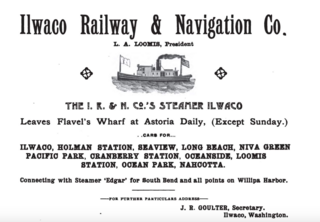
Ilwaco was a small riverine and coastal steamship built in 1890 which was operated as a passenger vessel for the Ilwaco Railway and Navigation Company, and later served in other roles, including tow and freight boat, cannery tender and fish packing vessel. Ilwaco was originally named Suomi.